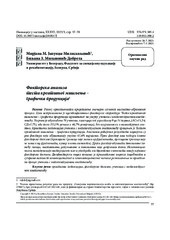| dc.creator | Japundza-Milisavljevic, Mirjana | |
| dc.creator | Milanović-Dobrota, Biljana | |
| dc.date.accessioned | 2023-10-23T08:05:35Z | |
| dc.date.available | 2023-10-23T08:05:35Z | |
| dc.date.issued | 2023 | |
| dc.identifier.issn | 0352-2334 | |
| dc.identifier.issn | 2335-0806 (Online) | |
| dc.identifier.uri | http://rfasper.fasper.bg.ac.rs/handle/123456789/5295 | |
| dc.description.abstract | Резиме: Развој креативности представља значајан сегмент васпитно-образовног
процеса. Циљ истраживања је идентификовање факторске структуре Теста креативног
мишљења – графичка продукција примењеног на узорку ученика с интелектуалном ометеношћу. Узорком је обухваћено 76 ученика, календарског узраста од 9 до 14 година, (АС=11,54;
СД=1,75), оба пола (53,3% дечака и 46,7% девојчица), без неуролошких и вишеструких сметњи. Креативни потенцијал ученика с интелектуалном ометеношћу процењен је Тестом
креативног мишљења – графичка продукција. Анализом добијених резултата издвојена су
два фактора који објашњавају укупно 67,6% варијансе. Први фактор има четири главне
факторске тежине (прекидање граница које зависи од фрагмената, прекидање граница које
не зависи од фрагмената, хумор и нови елементи). Други фактор обухвата повезивање помоћу линија, настављање, допуњавање и повезивање које доприноси теми. Неконвенционална манипулација материјалом као и употреба апстрактних елемената имају најмање
факторске тежине. Двофакторски модел показао је прихватљиве индексе подобности и
сугерише важност конвенционалног и неконвенционалног начина размишљања за креативни процес ученика с интелектуалном ометеношћу. | sr |
| dc.description.abstract | Development of creativity is an important segment of educational process. The goal of this research is to identify the factor structure of the Creative Thinking Test – Graphic Production of the applied on the sample of students with intelectual difficulties. The sample consisted of 76 students, age 9-14 (АS=11,54; SD=1,75), of both genders (53,3% boys and 46,7% girls), without neurological or multiple impediments. The creative potential of these students was tested using the Creative Thinking Test – Graphic Production. By analyzing the obtained resutls we identified two factors which explain the total of 67,6% of the variance. The first factor has four main factor weights (fragment-dependent boundary breaking, fragment-independent boundary breaking, humour, and new elements). The second factor includes linking by drawing lines, continuation, addition, and linking that contributes to the topic. Unconventional material manipulation as well as the use of abstract elements have the least factor weights. The two-factor model showed acceptable suitability indices and suggests the importance of conventional and unconventional ways of thinking for the creative process of students with intellectual difficulties. | sr |
| dc.language.iso | sr | sr |
| dc.publisher | Учитељски факултет Универзитета у Београду | sr |
| dc.relation | info:eu-repo/grantAgreement/MESTD/Basic Research (BR or ON)/179017/RS// | sr |
| dc.rights | openAccess | sr |
| dc.rights.uri | https://creativecommons.org/licenses/by/4.0/ | |
| dc.source | Inovacije u nastavi | sr |
| dc.subject | Кључне речи | sr |
| dc.subject | креативни потенцијал | sr |
| dc.subject | факторске тежине | sr |
| dc.subject | ученици с интелектуалном ометеношћу | sr |
| dc.subject | creative potential | sr |
| dc.subject | factor weights | sr |
| dc.subject | students with intelectual difficulties | sr |
| dc.title | Faktorska analiza testa Kreativnog mišljenja – grafička produkcija | sr |
| dc.type | article | sr |
| dc.rights.license | BY | sr |
| dc.citation.epage | 70 | |
| dc.citation.rank | M23 | |
| dc.citation.volume | 36 | |
| dc.citation.volume | 57 | |
| dc.identifier.doi | 10.5937/inovacije2303057J | |
| dc.identifier.fulltext | http://rfasper.fasper.bg.ac.rs/bitstream/id/10758/bitstream_10758.pdf | |
| dc.type.version | publishedVersion | sr |


